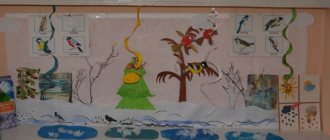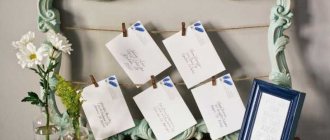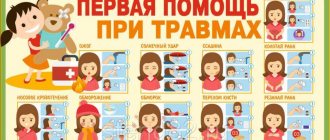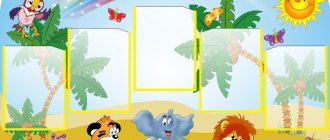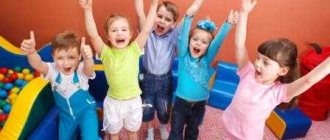Principles for designing a playroom in a preschool educational institution
1. Zoning
. It is necessary to divide the playroom into zones with different types of toys. This will avoid mixing gaming and educational processes.
2. Safety
. There should be no dangerous places in the room. You should stick soft corners on sharp corners, use plugs for heavy doors (stoppers), install limiters on windows for ventilation, purchase curtains for sockets, hide all wiring, and also pay attention to the floor - it should be smooth and warm.
3. Comfort
. Arranging a playroom begins with preparatory work. It is important to provide a suitable microclimate: temperature, humidity, lighting, fresh air flow. To monitor environmental indicators, it is better to install a weather station.
4. Saturation and variability
. The equipment of the game room should be varied and colorful. This will not only give children a choice, but will also decorate the room. It is desirable that the equipment provides all types of activity: motor (including fine and gross motor skills), cognitive, research, creative, joint. Also, do not forget to periodically update the game material.
5. Availability
. The playroom equipment should be located within the child’s reach so that he can use it independently at any time. Toys must be in good working order, appropriate for the age, and, if necessary, the limitations of the children.
6. Transformability and multifunctionality
. You will be able to use your budget rationally with equipment that is interesting to children of different ages and has various options for use. For example, soft modules are suitable for relay and building games, as well as for recreation. At the same time, both babies and older children (preschoolers) love them.
Role-playing game: HAIRDRESSER
A beauty salon or hairdresser is required in every kindergarten group. As a rule, children's furniture is purchased and filled with all the necessary accessories. Toys purchased in the store can be supplemented with various jars of shampoo, cream, cotton pads, combs, curlers, mirrors with safety glass and much more that fits the theme of a hairdresser and beauty salon.
An important element is a cape for the client and an apron for the hairdressing salon employee. Through these objects, children transform into their roles and begin to play them out in the plot. Simple costumes can be purchased in specialized stores for preschool educational institutions or sewn yourself.
The Hairdresser's corner in kindergarten is an island of femininity and beauty. Every girl will pay attention to it and will play there with great pleasure.
In the photo you see the “Hairdresser Set”, which includes everything you need: plastic accessories, a hairdresser’s cape. It is packed in a pink suitcase. We found this set in the Kindergarten store here >>>
Interior design and architecture
All materials in the playroom, including construction materials, must have certificates confirming their origin, quality and health safety. Also, materials must be resistant to wet cleaning and disinfection. In accordance with these requirements, the following options are possible for the design elements and architecture of the game room:
1) floor, walls, ceiling
. According to the standards, the area of the playroom for early age groups (children under 3 years old) is determined at the rate of at least 2.5 × 2.0 m per child, for preschool age (children 3–7 years old) - at least 2 .0 × 2.0 m. The following floor coverings are allowed: linoleum, parquet, cork flooring, carpet. You can put, for example, a puzzle mat on top. To paint the walls, choose matte light colors: sand, turquoise, cream, coffee, light pink, lilac, etc. The walls can be decorated with children's images, vinyl stickers, paper applications, posters, etc. The ceiling can be either a regular whitewashed or painted, tiled and fabric stretched;
2) windows, lighting, furniture
. Curtains or blinds in light colors are required on the windows. Lighting (warm, perhaps with a yellowish tone) should be general and uniform, without open spotlights or harsh light. The sizes of drawers, cabinets, shelving and other furniture are selected according to the age of the children. In this case, the color of the furniture is allowed to be bright.
Role-playing game: TRAVEL BUREAU
A corner of the world in a kindergarten (or travel agency) actively contributes to the child’s learning of important geographical and political-economic concepts. For children who have never been to other countries, it can be really difficult to understand the true scale of the world, and the traveler's corner successfully solves this problem. In addition, the game of travel is a powerful stimulator of interest in learning about the world around us. In addition, the travel agency can organize a game program for traveling even to space or to the bottom of the ocean.
Another unique function of the corner of the world in kindergarten is the ability to link it to the study of foreign languages, which is undoubtedly very important. For a preschooler who is learning a foreign language, it is important to become familiar not only with the alphabet and basic rules of grammar, but also to learn the culture and traditions of other countries, which is also successfully implemented in the space of a corner of the world in kindergarten.
In the photo you see a talking poster “Living Geography”. It makes it easier for children to study and understand the nature of our Earth. This is modern equipment for home and kindergarten. In the second photo: Physical Earth globe, d-250 mm.
Game room areas and their contents
As already mentioned, the playroom needs to be divided into play corners so that children can choose the activity they like. Each play area has its own educational functions and its own design. Next, we will consider the most common options for corners and their filling.
Construction games corner
needed to develop the child’s creative abilities and logical thinking. For this purpose, constructors are used that differ in material, shape, fastenings and sizes. In the best way, children will be given an idea of the weight and size of objects, and will be taught balance and orientation in space by large soft construction sets.
Corner of physical education and sports
will appeal to lovers of active physical activities. Sports equipment is placed here, with which you can independently practice various exercises. Soft sports modules that are easily transportable, multifunctional and safe will fit perfectly into the game room.
Corner of relaxation and privacy
- This is a place where children relax and gain strength. The corner can be either closed (a hut) or open, with comfortable frameless upholstered furniture. Poufs, pillows and pear chairs are also ideal for arranging a relaxation area, on which you can relax and lie down.
Active games corner
- a zone of complete freedom. Here children have the most opportunities to splash out energy through outdoor games. Various contour toys, dry pools and slides will help them with this.
Touch Corner
develops tactile perception. Children form ideas about the properties of objects and various phenomena by exploring them by touch. For this purpose, they choose didactic floor toys with various fasteners, locks, lacing, geometric shapes, etc. Such props perfectly develop fine motor skills and are used with pleasure by children in games. Also in the sensory corner, paths with different surfaces are desirable - ribbed, smooth, soft, slippery, hard, prickly, etc. Walking along paths is not only a fun activity for a child, which develops tactile sensations, improves the psycho-emotional state, but also a useful massage (prevents and treats flat feet, improves the sense of balance, etc.).
Corner "Road Rules"
needed to practice safe behavior on the roadway. The best way to do this is to use themed props (soft large cars, bibs with pictures) and role-play various situations with children.
Corner of role-playing games
Helps children develop imagination and communication skills. The setting of this zone should correspond to the game plot and the invented children's roles. Younger preschoolers, as a rule, give preference to plots based on the objects present; with their help, it is easier for them to get involved in plot-role-playing games. It is recommended to decorate the corner thematically. Ready-made corner options can be found among the so-called soft play sets.
Role-playing game: DUTY corner
The concepts of discipline and housekeeping begin with duty in kindergarten. Since learning and development in kindergarten takes place in a specially organized everyday environment, it is necessary to create a pedagogically effective situation from this. In other words, in no kindergarten can the responsibility for organizing children’s lives be placed entirely on the shoulders of adults. Even the smallest children, to the best of their ability, should be involved in the most important everyday issues, because this activity contains the most important educational element.
In the duty officer's corner in kindergarten, children should become familiar with the basic rules of housekeeping, as well as learn how to handle a variety of household appliances. Especially for safety reasons, toys are developed for children that are as similar as possible to real household items and equipment, but, however, are only an imitation of them. However, this does not reduce the effectiveness of the educational process, the purpose of which is to instill in children the skills of housekeeping, as well as to instill responsibility and a love of order.
In the photo there is a set called - Cinderella Play Set No. 4. It is produced by the old plastic toy factory Sovtekhstrom. The quality of the toy is good, the price is very affordable!
Preliminary work
Excursion to television: examination of the setting of the film set and equipment, explanation of the purpose of stands, signs,
monitoring the work of television workers. Observing how TV shows are filmed. Television workers talk about their work.
Conversations with children about the media, the role of television in people’s lives: “What is television for”, “Favorite TV shows”, “What can replace a TV”, “How is a TV show filmed”, watching the presentation “Where did television come from”, “Who works on television”, watching educational and entertaining television programs.
Reading literary works by A. Barto “Strong Cinema”, “In the Cinema”, M. Zoshchenko “Actor”, M. Prishvin “The Beginning of Autumn”, B. Zhitkov “How Light Goes Through Wires”, M. Alimbayev “What a Strange Country "
Didactic games: “Cut pictures”, “What fairy tale is this from?”, “What’s missing?”, “Correspondent”, “Make a cartoon”, “Who can name more TV shows”, “Who needs what for work”, “What The director needs it."
Exhibition of children's drawings “Children's Television”, “Cinema through the eyes of children”, “Advertising for the play” (collective work), drawing signs, collective collage “On Television”.
Compilation of a mini-encyclopedia “All about television”.
Developing subject-game environment: computers, video camera, cameras, bag for television equipment, “TV”, microphone, telephone, walkie-talkie, “cracker”; symbolism of various programs; costume elements, makeup, cosmetic sets; interior elements, decorations, screens, photographs; costumes for theatrical activities, masks; logo of the program in the form of an application, identification badges for participants
filming (hosts, cameraman, reporters, guests of the program).
Role-playing game: MAIL
We live in an era of information dominance.
It is thanks to the fact that people have learned to communicate with each other across vast layers of time and numerous kilometers of space that humanity has been able to take a huge step in its development.
Despite the fact that information in the world is now capable of being transmitted from one end of the globe to another in a split second, we must not forget that it all started with mail. And that, despite modern technology, this area of human activity still functions and flourishes.
By playing mail, a child in kindergarten will not only get acquainted with the fascinating processes of information exchange, but will also understand how important these processes are.
By signing postcards and sending letters by mail, the child will not only learn to correctly formulate his thoughts and wishes, but will also understand that, thanks to mail, not only texts or images, but also human emotions and feelings can be transmitted over vast distances.
In the photo: children's role-playing costume “Mail”. It includes a cap, a cape and a bag with the inscription “Mail”. This is an inexpensive and practical suit. It is made of raincoat fabric, so it is easy to clean.
Role-playing game: THEATER
It is difficult to list all the advantages of theater as the most important developmental activity for a preschooler.
When children participate in a performance or even just watch it, a whole series of processes that are most important in pedagogical and psychological terms take place, starting from training the ability to empathize and understand the emotions and feelings of other people, and ending with aesthetic education and cultural development.
No wonder A.S. Makarenko made theatrical performances in his education system the most powerful and one of the most important means of influencing children for pedagogical and educational purposes. Perhaps the most important function of theatrical performances in a kindergarten is psychotherapeutic. By playing the role of a character, or simply empathizing with him, a child can get rid of various problems in the emotional, sensory and social spheres that inevitably arise even in preschool age.
In the photo: knitted finger theater, produced by IP Nikulina. Excellent quality! The characters are easy to put on your finger. They are hand knitted. In the second and third photos: characters from the walking theater. Development of Russian manufacturers of didactic equipment “Naive World”. The fingers are inserted into special loops that are sewn to the back of the doll. By moving your fingers, you move the doll's legs. A very interesting development. Sets based on fairy tales and just individual dolls are sold in specialized stores for kindergartens.
Role-playing game: BASED ON RUSSIAN FOLK MOTIVES
One thing distinguishes a folk toy from a modern one - the vast experience of our ancestors and their endless wisdom, which is embodied in every folk product.
Please note that folk toys are practically immortal - children of different generations have been playing with them for hundreds and thousands of years, and no modern technology can challenge or surpass their effectiveness.
In addition, the wisdom of the people endows toys with enormous symbolism, which, undoubtedly, is perceived by children at least on a subconscious level.
For example, nesting dolls symbolize the sanctity of motherhood and the continuation of the human race, and the whimsical Russian folk decorative painting, which decorates almost all folk toys, conveys to the child information about the structure of the world, encrypted in visual and color symbols.
Thus, a Russian folk toy in kindergarten is more than a means of instilling patriotism. This is also an opportunity to convey to children the experience accumulated by people over a huge period of time.
In the photo: our traditional educational toy is a matryoshka doll.

